La Liga has been dubbed a two-horse race for far too long. For the modern fan, there were ever really two real title contenders every year – Barcelona and Real Madrid. These two giants of Spanish football would battle it out season upon season to sit at the throne.
In 2020/21, however, we have a different story and an unexpected competitor challenging for the crown – Atletico Madrid. Diego Simeone already has a title under his belt but that was way back in 2013/14 and it’s high time for them to do it again.
Since that moment, the Rojiblancos have won the Europa League and have been to the Champions League final multiple times, but always felt short. So why does 2020/21 feel different for some reason?
Atlético Madrid are currently top of the table heading into the second part of the season and Simeone’s troops are looking better than ever. For that reason, this tactical analysis will aim to uncover Cholo’s newfound tactics and philosophy and also do a data analysis to see whether the numbers back up the eye test so far.
Are Rojiblancos truly title contenders or even better, title favourites? Let’s find out.
Statistical & squad overview
The summer of 2020 was quiet compared to the previous year for Atlético Madrid. The majority of the rebuild was done in 2019 and the following transfer windows were mostly used to iron out the details and fine-tune where necessary. And yes, the likes of Yannick Carrasco and Geoffrey Kondogbia had also arrived but they were not big-money signings that would shake the market and the footballing world as a whole.
Simeone already had the tools at his disposal but would need some time to get them all ticking. Before delving into the analysis, let’s take a quick look at their current roster and see what’s changed.
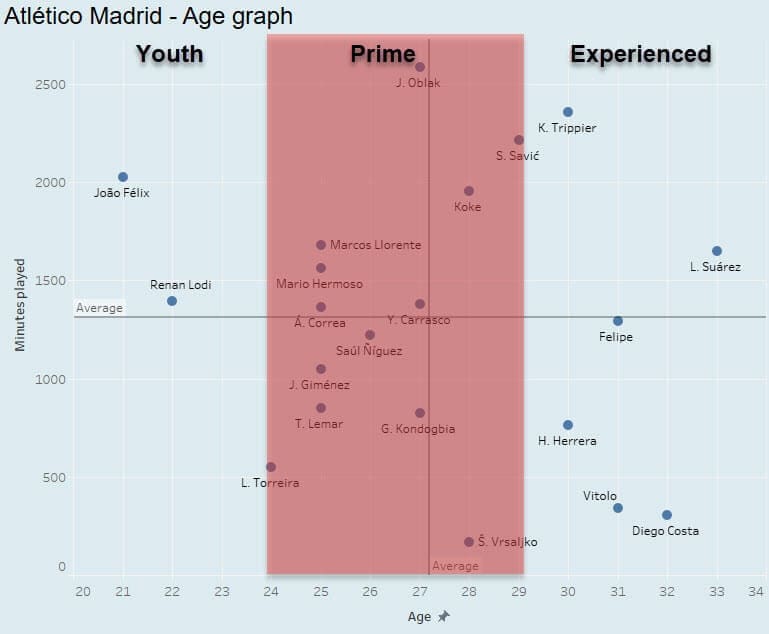
The first image is an age graph that shows us Atlético Madrid’s 2020/21 squad along with their minute tally and age group. We’ve divided them into youth, prime and experienced players to see whether Simeone has truly refreshed his team as the narrative suggests. It turns out he most certainly did.
The only experienced players with an above-average game time in 20/21 so far are Luis Suárez and Kieran Trippier, both of whom have big roles to play in the team. Of course, Stefan Savić is slowly entering that category and Koke is getting closer too while we can also say Felipe is an important piece of the jigsaw as well.
However, the likes of João Félix, Renan Lodi, Mario Hermoso, Marcos Llorente, Ángel Correa and Carrasco are proof that players in their youth and prime years are dominating the squad.
With such a drastic change, 2019/20 was a rollercoaster for the Rojiblancos as they trailed for the first part of the campaign, only to rise post-break and clinch a spot among La Liga’s best, albeit missing out on silverware yet again.
But despite shaky results and inconsistent performances, the numbers were good and it felt Atlético were moving in the right direction. And now, it’s all finally coming together. The next image is a running expected goals (xG) chart which visualises their figures from the start of 19/20 until now.
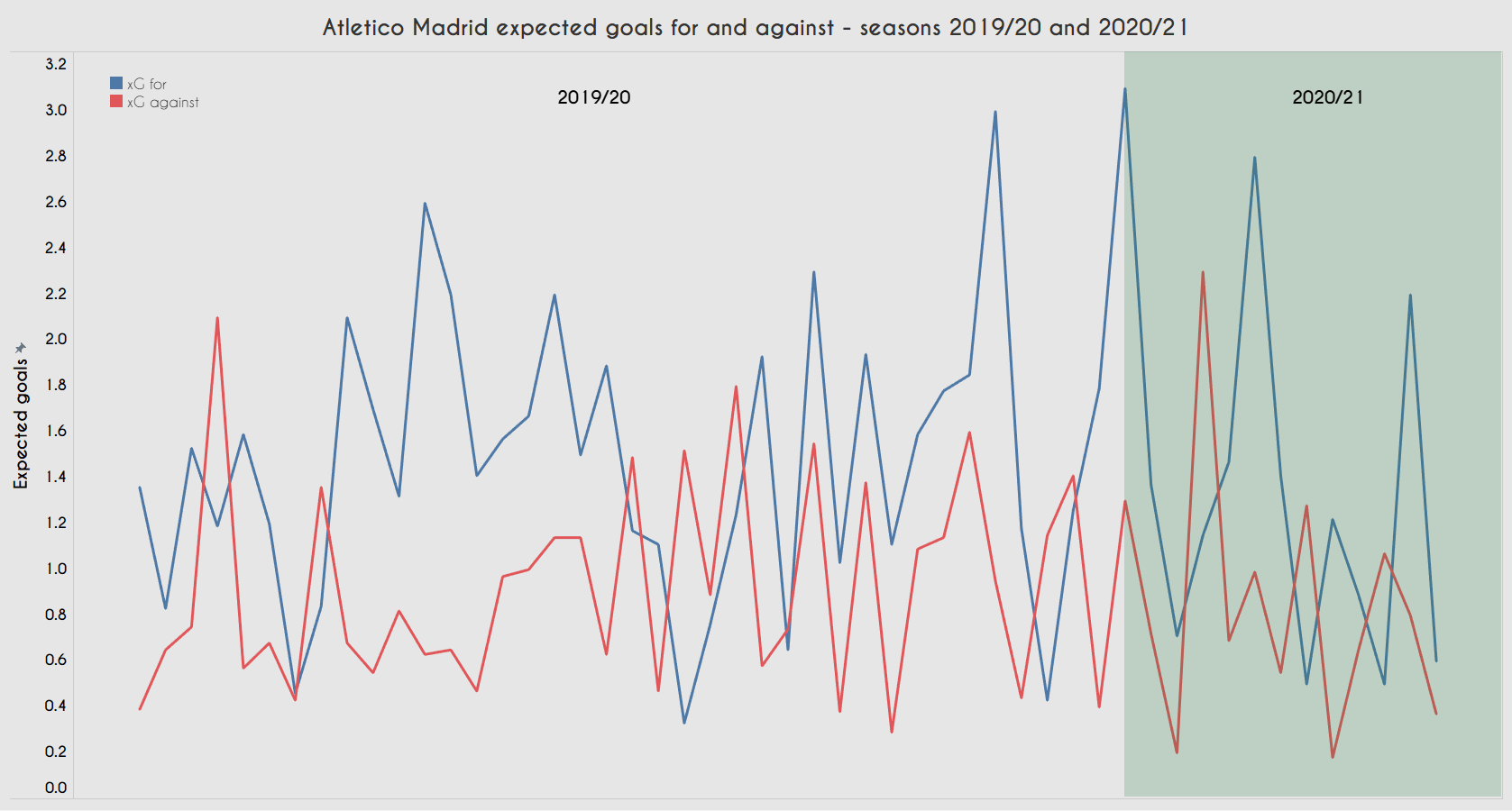
We can see that the data supports the narrative – the first part of the season the team was struggling for both results and the performances were not there yet. Simeone was adamant on tweaking his tactics and philosophy to a more aggressive and dominant style as opposed to the purely defensive and compact outlook.
A clear change happened towards the end of 19/20 as they finally found the winning formula that combined attacking proficiency with defensive solidity, resulting in what was seen as drastic improvement within the squad.
If there was more time last season, maybe Atlético would accomplish even more but luckily, the trends continued into the following campaign as well. Our next graph is a comparison between the two seasons with a slight caveat of a smaller sample for 20/21.
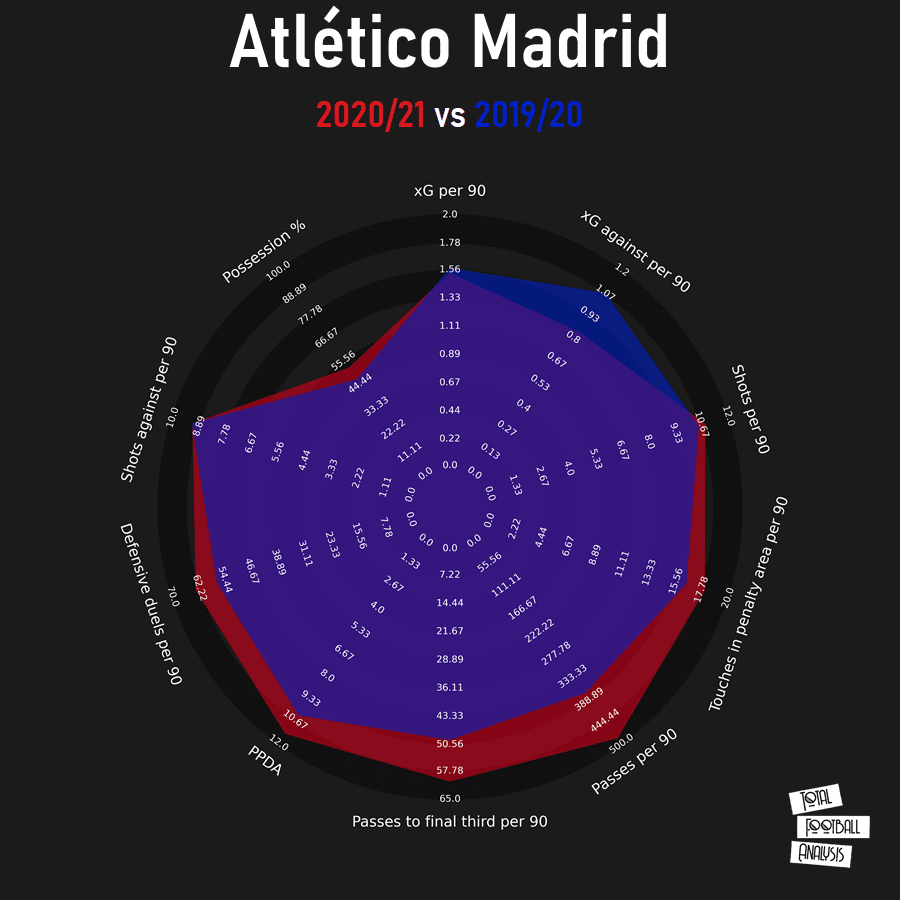
Still, the changes are quite telling to say the least. Their xG per 90 has remained consistently high while they have drastically improved their passing and possession figures. On top of being more efficient in attack, Atlético seem to be even tougher to breach now as well.
They may not press as aggressively as before, as indicated by a higher PPDA (passes allowed per defensive action) value, but their expected goals against (xGA) have decreased significantly and they seem to register more defensive duels per 90 as well.
Overall, Simeone has made Atlético Madrid deadlier and more proactive in attack while somehow turning them into even better defenders than was the case before. This, needless to say, is truly a winning formula.
But what tactics and personnel lie behind their success?
Build-up tendencies and progressiveness
Without a doubt, the thing that has changed the most in Simeone’s tactics is the sheer approach to their build-up phase. Atlético Madrid aren’t the first team that comes to mind when you talk about in-possession mechanisms but they’re starting to stand out in that aspect as well.
We’ve already noticed in the previous section of this tactical analysis that the Rojiblancos have altered their style of play significantly but let’s examine that a bit further. In the following graph, I’ve attempted to define every La Liga team’s style of play by comparing their long passes per 100 passes and possession percentage.
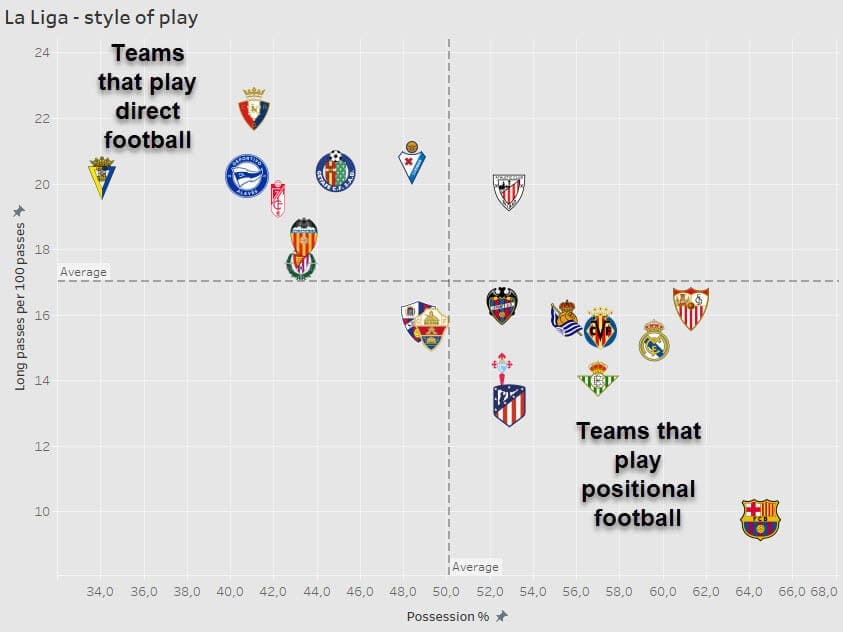
All the teams that prefer long passes in their tactics and have lower possession are depicted as more direct and counter-attacking while the teams on the polar opposite, in the lower-right quadrant, are positional.
While usually you’d expect Atlético Madrid to be somewhere in the middle or even towards the top-left, now they’re firmly among the positional teams in Spain. So much so that their 13.23 long passes per 100 passes are only higher than Barcelona’s 9.74 in La Liga.
Before analysing some of their patterns and systems, let’s see who are the key pieces in Simeone’s build-up jigsaw and next, you can see a graph dealing with progressiveness within their team.
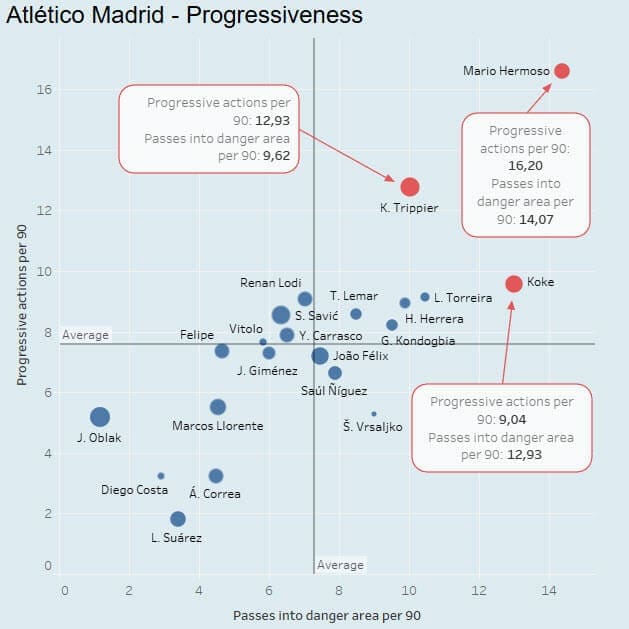
To establish which players aid the progression the most, I’ve compared two of the key categories: passes into danger area per 90 (passes into the final third + passes into the box) and progressive actions per 90 (progressive passes + progressive runs). Note, however, that the bigger the circle the more minutes the player has played so far in 20/21, which is very important here.
According to the data, Hermoso, Trippier and Koke are Atlético Madrid’s crucial pieces in the build-up phase. In the former player’s case, this would usually be a surprise but Simeone has turned him into a highly effective ball-playing centre-back who deploys 14.07 passes into danger area and tallies 16.2 progressive actions per 90.
As mentioned, the major change that’s happened there has to do with a slight alteration in their build-up structure. Simeone now deploys a back three in possession with the aid of a double-pivot to progress the ball from the first third. Hermoso is the one to drop next to the two centre-backs to the left and is given the licence to distribute the ball forward, hence such a surge in his statistical output. The eye test confirms it.
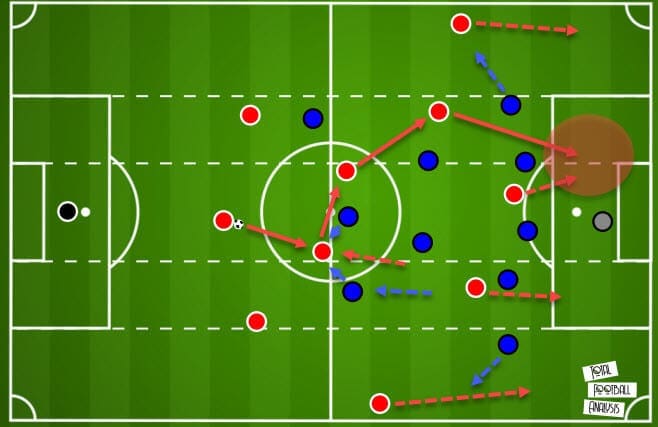
The image you can see here is Atlético Madrid’s build-up scheme they used against Bayern Munich in the Champions League. You can clearly see the 3-2 structure in the first phase of build-up and how it enables them progression. Hermoso, José Giménez and Savić are in a back three and their task is to find either the pivots or the forwards in danger areas.
Space between the lines is crucial when it comes to their new approach so the first thing they’ll look to reach are the two pockets in the half-spaces. The half-space holds a strategic advantage as it puts the defenders in a decisional crisis, forcing them to choose between two equally risky courses of action.
But in Atlético’s case, it’s also where they will usually find Félix, another crucial piece of their tactics. The next image is a graphic depicting their in-possession structure but this time, however, it shows the pressure points in their attack.
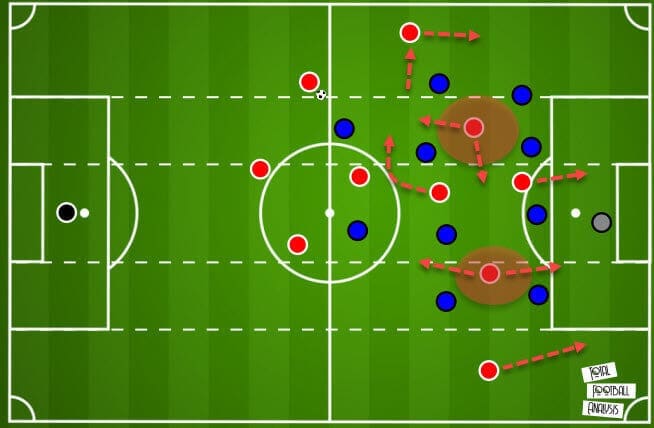
Simeone’s game plan is not exclusively ‘get the ball to Félix’ but he is the main focal point in their attack. And for good reason too. But looking at the graphic above, we can see that the behaviour of their central midfielders is also peculiar. One will usually stay deeper to offer support to the backline while the other is more fluid in his movement, positioning himself higher or deeper depending on the situation.
That role is usually Koke’s and the midfielder’s versatility is undoubtedly key to Simeone, as we’ve also seen from the progressiveness graph. Alongside Hermoso, no other player deploys as many passes into the danger area within the squad for an average of 12.93 per 90 minutes.
The following image is a good example from the Rojiblancos’ latest game at the time of writing, against Deportivo Alavés.
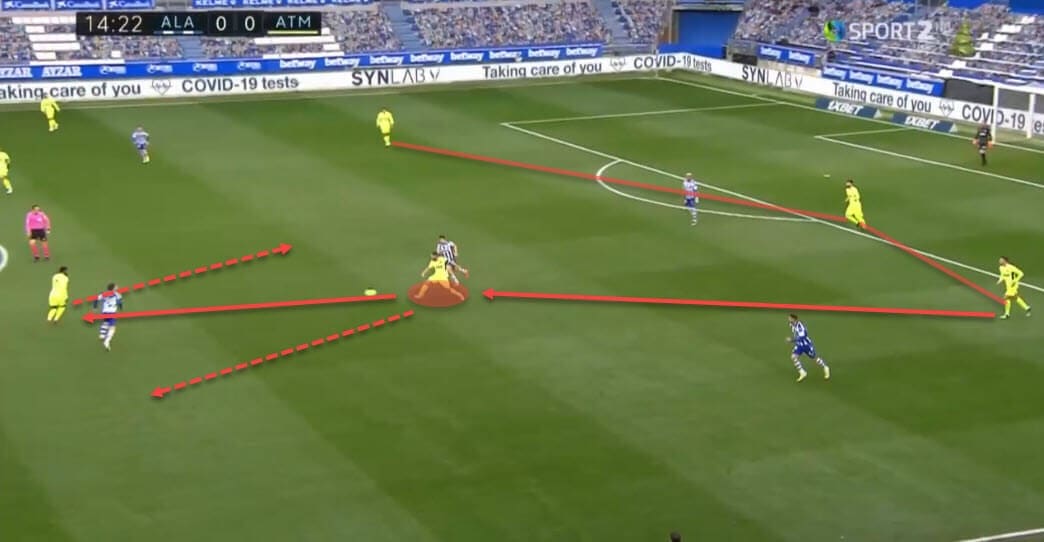
You can see Atlético Madrid’s basic in-possession structure with Koke dropping deep to assist the build-up and beat the press. As soon as he’s relieved the backline, he deploys a pass to Thomas Lemar and takes his place higher up the pitch. We can often see him fluctuate between different areas on the field throughout the 90 minutes, which makes their attack fluid and unpredictable.
Final third efficiency
So we’ve concluded Simeone’s new build-up mechanisms seem to be highly effective at turning Atlético Madrid into a solid positional team. However, while crucial, a good first phase of attack won’t matter much if the team lacks efficiency once they enter the final third. Fortunately for the Rojiblancos, that doesn’t seem to be a problem for them.
As was the case with the previous sections of our tactical analysis, let’s start with some general comparisons with the rest of La Liga. Next is a graph depicting all Spanish teams’ attacking proficiency by measuring their expected goals (xG) per 90 and goal-creating actions per 90.
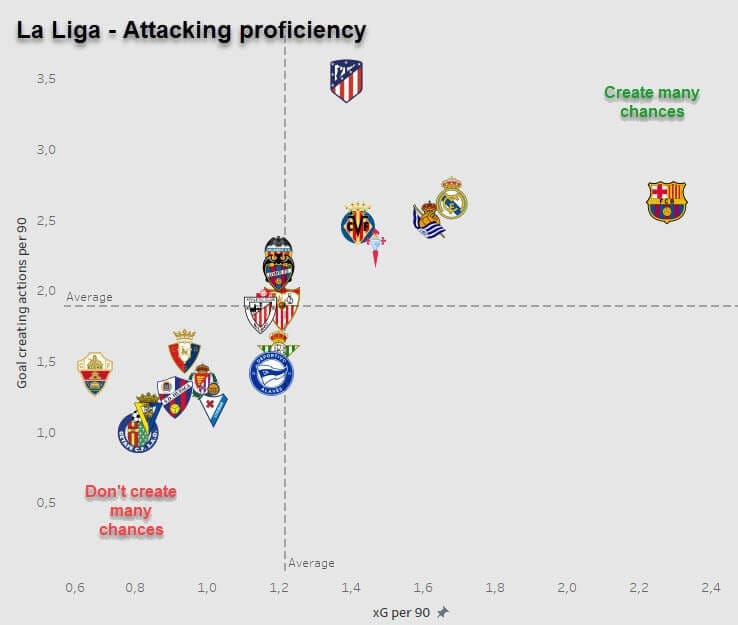
With 3.47 per 90, Atlético are the team with the highest volume of goal-creating actions in La Liga and also among the ones with the highest xG per 90 figures as well. This is further proof that the good tendencies from the 2019/20 season have been transferred and even improved upon in 2020/21.
We’ve already touched upon some of their main structures in attack but we’ll delve deeper into the attacking tactics in this section of the analysis. Before that, however, we have to identify their crucial pieces in the final third by measuring their creativity and lethality, two of the most important aspects in attack.
The following image is a graph that will show us Atlético Madrid’s best creators by measuring two custom made categories I’ve created: creation, which consists of second assists, third assists and shot assists per 90, and decisive passing which is key passes and deep completions per 90 in one. Note that the brighter the colour (red being the highest), the higher the player’s expected assists per 90 figures are too.
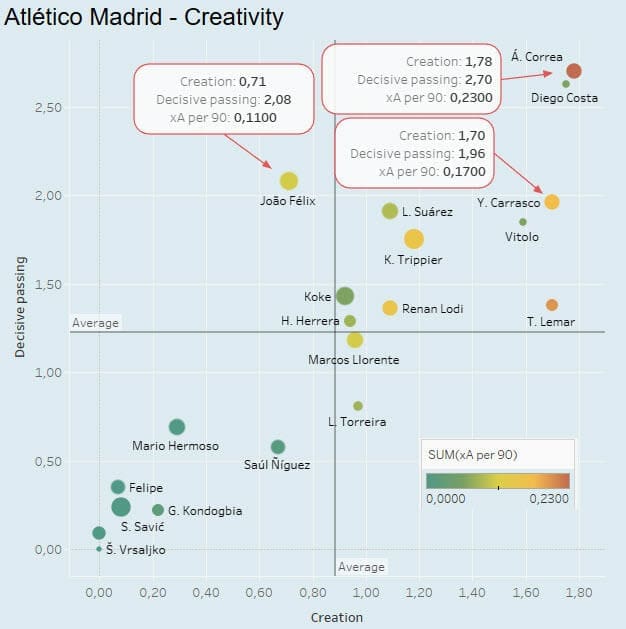
By combining those metrics, we aim to get a pretty good understanding of their crucial pieces in the creation of chances. I’ve decided to highlight three players in the graph: Correa, Carrasco and Félix since all three have enough minutes and don’t necessarily have a high figure simply due to their continuous attacking role and presence in the box.
All three are attackers, yes, but all three tend to drop when needed, offering an additional passing channel, creating overloads and connecting the thirds efficiently. This is especially true for Félix who, despite not topping the charts in these metrics, is the main piece of the jigsaw. We should also mention both Suárez and Trippier as highly effective too as the former still demonstrates his ability as a modern number nine while the latter is a perfect example of a more offensive full-back, as opposed to Hermoso, for example, who has become a distributor instead.
But Félix feels and plays differently than before and it’s visible in both his movement and stats. He’s experienced a significant increase in almost every category imaginable, from through passes, passes to final third, xA per 90, forward passes and more importantly, received passes which jumped from 19.77 per 90 in 19/20 to 32.21 per 90 in 20/21.
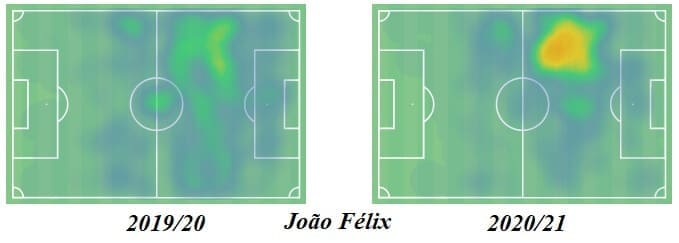
His heatmap tells a similar story. While before, he seemed to roam much more often, now he consistently drops deeper to progress the ball and aid the build-up. But that hasn’t stopped him from being a highly influential player in the final third, which we’ll touch upon shortly.
When entering the opposition’s box, Atlético Madrid have finally gotten rid of their ghosts of the past, eliminating the inconsistencies in front of the goal. Now, their finishing is fitting of La Liga favourites as they’ve amassed 29 goals from 20.9 xG, overperforming it massively. Whether this is a sustainable trend or not remains to be seen, but there’s no escaping the stats.
Let’s now see who are the main contributors to these incredible results. Our next image is another graph I made which depicts shots per 90 and touches in the box per 90. This time, the brighter the colour, the higher the expected goals per 90 figures are with red being the highest again.
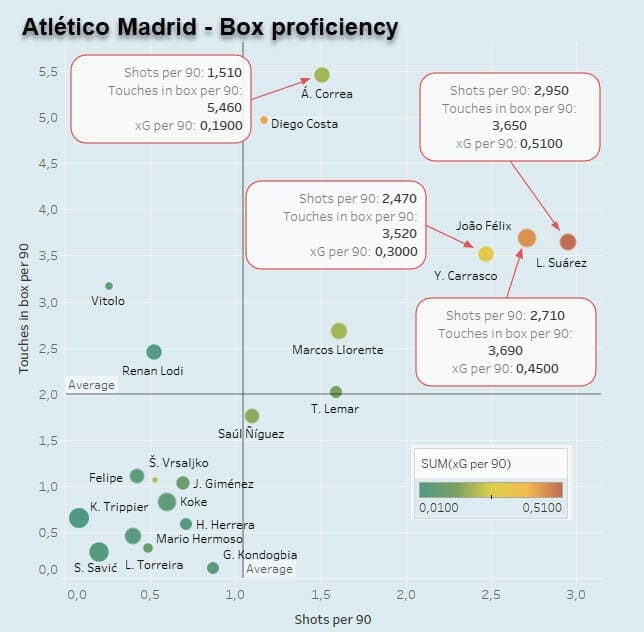
Without a doubt, the inclusion of Suárez from Barcelona was crucial for the team as he’s La Liga’s top-scorer at the moment of writing, tied with some other big names, and tallies the highest figures for shots per 90 and xG per 90 within the squad.
But the Uruguayan is closely followed by Félix and Correa respectively, albeit on slightly different ends on the graph. The former has a profile much closer to Suárez himself while the latter registers the most touches in the box by far at Atlético Madrid. All three, however, are highly influential for their attack.
Finally, and before moving to the last section of this tactical analysis, we’ll quickly take a look at a couple of examples of their space occupation, which was alluded to earlier in the piece. I’ve taken both examples from one of my earlier articles on Atlético Madrid in 20/21 which serve the purpose perfectly.
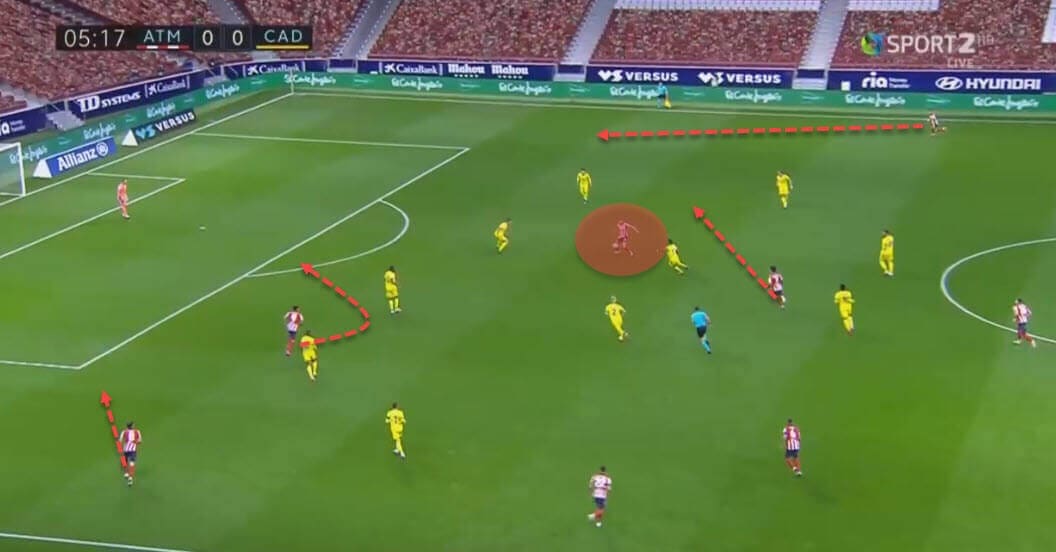
The first one shows Félix and Correa in action as the latter receives the ball in that pocket near the half-space while the former makes a run from deep. This is the trigger for the other attacking players to start their runs into the box as one of their main creators takes possession.
From there, Correa can deploy passes further into the danger area, looking to serve the ball to one of the other forwards. The same is true when Atlético Madrid have possession out wide, which can be seen in the second image.
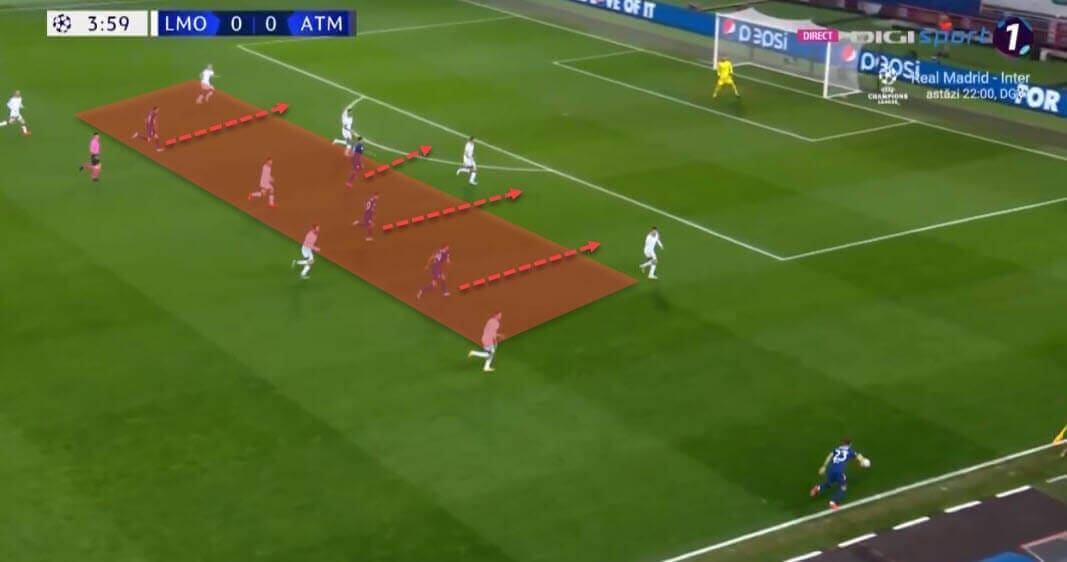
Trippier is on the ball and as he moves forward inside the final third, it’s an immediate cue for the whole attacking line to move forward from their position between the lines. By overloading the box, the Rojiblancos ensure a higher chance of a cross successfully finding a teammate in the crowd.
Defensive tactics
Looking at the team as a whole, it does feel like Simeone has changed the defensive tactics the least in comparison to their attacking repertoire. Atlético Madrid still defend in a highly compact 4-4-2 structure and aim to direct the opposition wide where it’s easier to collapse and recover possession.
For that reason, this section of the tactical analysis will be the shortest one. Firstly, let’s check their defensive solidity when compared to the rest of La Liga.
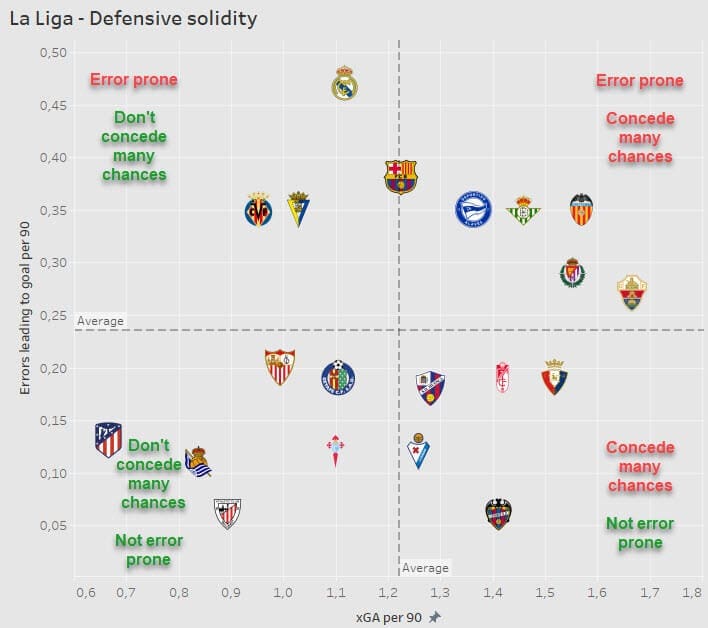
The graph here measures expected goals against (xGA) per 90 minutes and errors leading up to goal per 90. Without too much doubt, Atlético Madrid are the most defensively solid team in La Liga, followed by Real Sociedad and Athletic Club.
It has to be noted, however, that the error proneness correlates with possession % because teams who see more of the ball have a higher chance of making a mistake in possession as well. But Atléti are a positional team that only makes 0.13 errors leading to a goal per game and tallies only 0.67 xGA per game, the lowest in the league.
Compare that to the likes of Real Madrid and Barcelona, both of whom are quite leaky, especially the latter, and you can start forming the picture. The lower left quadrant is the ideal one while its polar opposite, the top-right, is the one where generally the worst defensive teams are located.
Following the same structure, let’s first identify the most important defenders in the team throughout the 2020/21 season thus far.
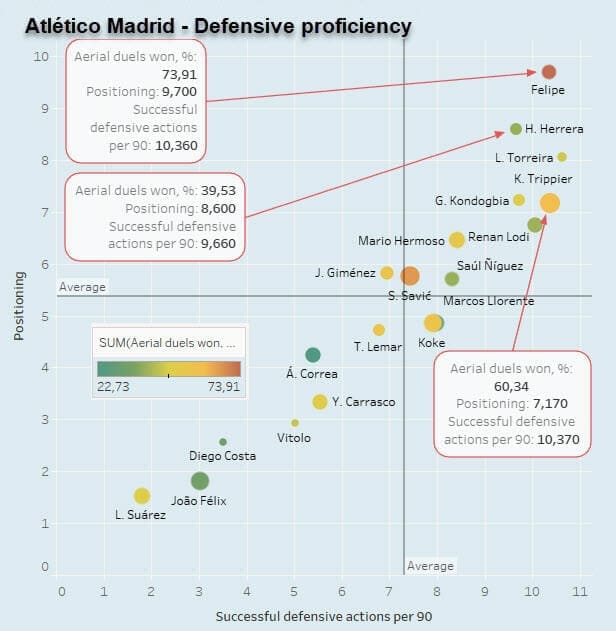
I’ve decided to look at three main categories with this graph: successful defensive actions per 90, positioning, which includes shots blocked per 90 and possession-adjusted interceptions, and aerial duels won %, depicted by the brightness of the colours.
Analysing the metrics, it seems that all three of Felipe, Hector Herrera and Trippier are the most defensively proficient despite the latter having a very attacking role within the team. Of course, there are other impressive names on the list but we have to be wary of game time before making our final verdict, which is why I’ve opted for these three ahead of the others.
Now we can see a couple of tactical setups in the defensive phase that have served them well both in the past and so far in 2020/21. We’ve already mentioned their compact block that forces the opposition wide. They will gladly sit in a 4-4-2 structure, inviting the opposition into the middle third before engaging in a more aggressive collapse.
This is also evident from their increase in PPDA from 10.35 in 19/20 to 11.44 in 20/21, the latter also eclipsing the league average of 11.19. The higher the value, the less the team presses in general. The goal, instead, is to shut down any chance of central progression for the attackers, either forcing them wide as mentioned earlier or luring them into a trap down the middle.
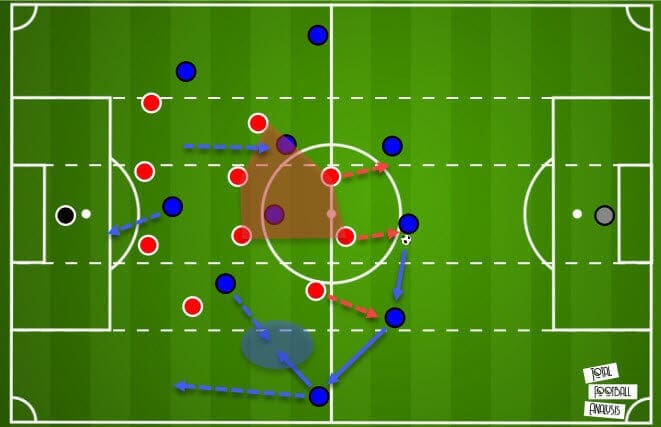
Here is a graphic I’ve created for my preview of Atlético Madrid’s clash against Barcelona and I’ve decided to use it here once again. You can see how the Rojiblancos go from a 4-4-2 shape into a 4-3-3 and compress the middle of the pitch. In that specific example, I’d expect Barcelona to drop an additional midfielder into the backline to achieve numerical superiority and activate the second line of press.
However, even with that being done, their only real option is to go wide and use manipulation to bypass the block. This is exactly what Simeone wants because now they can use the touchline as an additional man to easily create an overload on the attackers.
We can see a fairly similar example down below as the Rojiblancos use a heavy man-marking scheme to trap the opposition out wide.
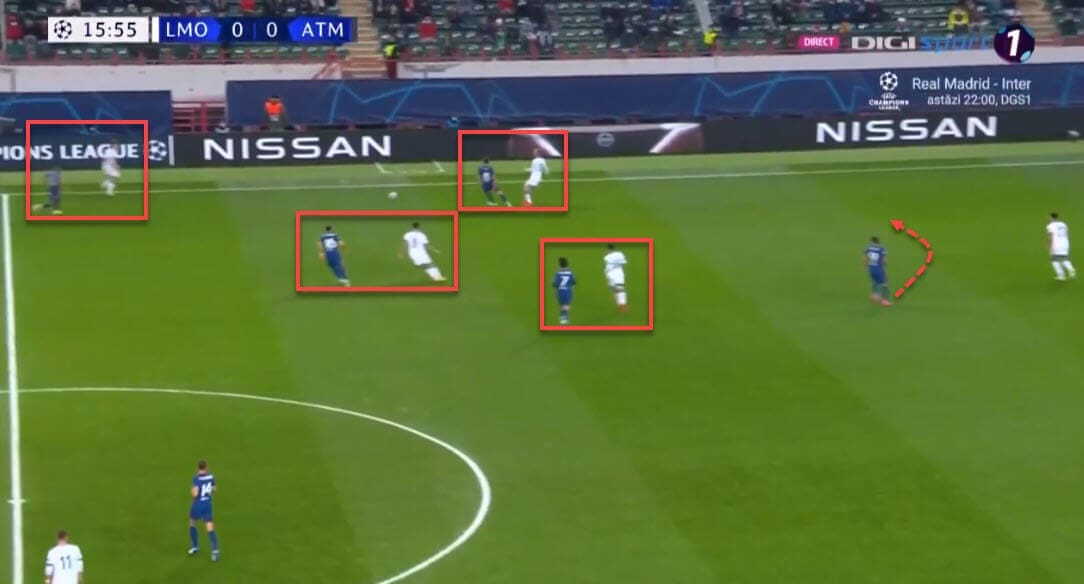
Also note how the striker, in this example Suárez, makes a curved run to shut the channel leading back to the defenders in case progression can’t be achieved. That run also creates a 5v4 overload, ensuring Simeone’s troops have numerical superiority while defending.
Conclusion
It’s still fairly early in the season but Atlético Madrid are looking confident. Simeone has successfully altered his tactics and philosophy to a more positional approach with a focus on the offensive. It has taken them a while to get used to the new setup but now, both the stats and the eye test confirm the Rojiblancos as the title-contenders at the very least.
At this rate, they are projected to win their first La Liga title since 2013/14 and do it in style. But can they sustain this level of performance until the end of the campaign?
That remains to be seen.

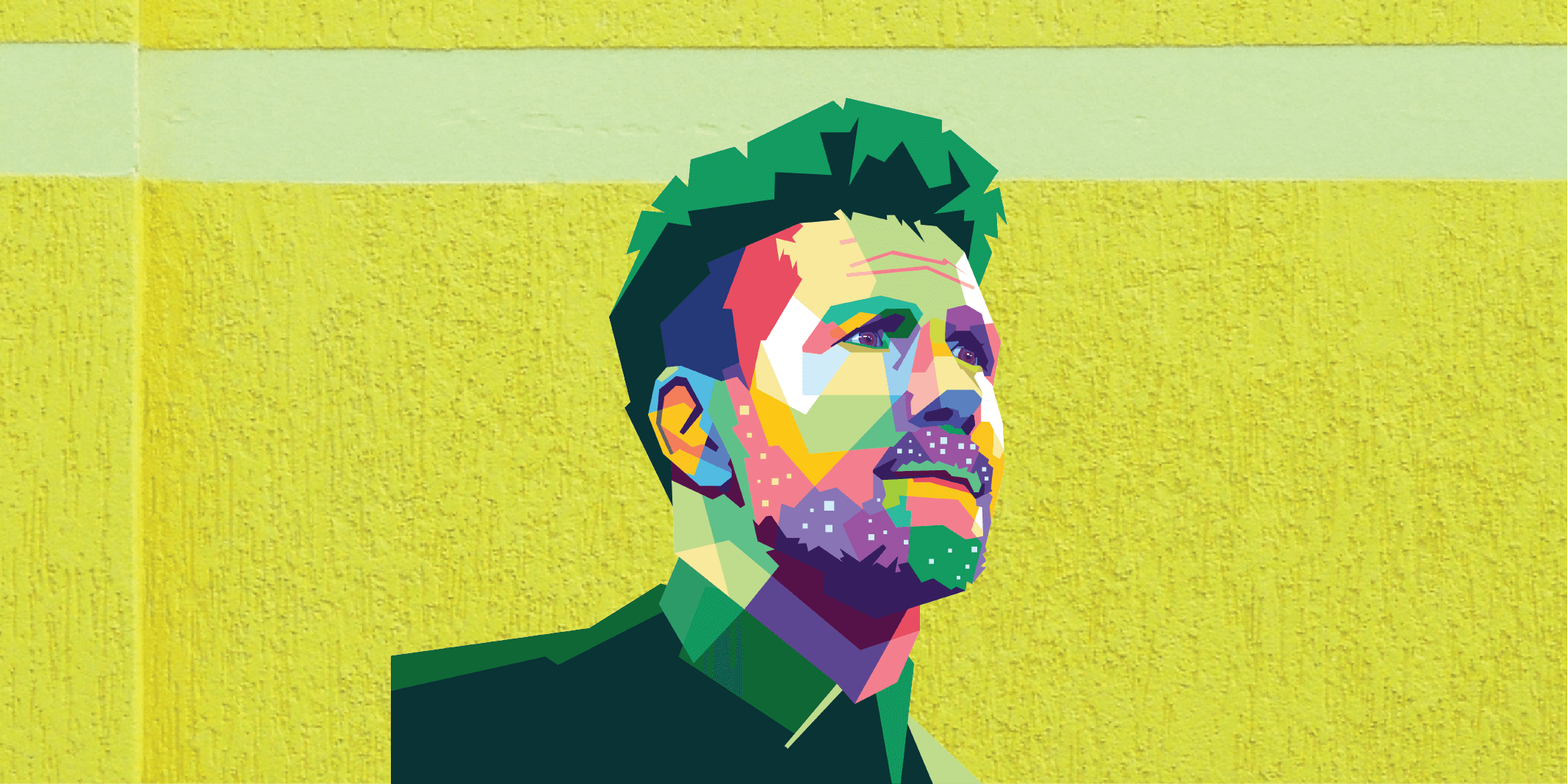




Comments